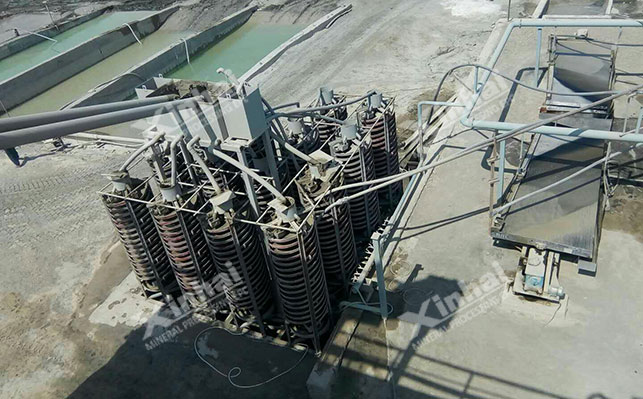If you want to know more information (such as product/process price, etc.), please contact us 24-hour telephone
In the field of mineral processing, gravity separation technology is a key method for crude iron ore recovery. The following is a detailed introduction to the technology.
Gravity separation is based on the difference in mineral density, and coarse-grained minerals are separated by water flow, vibration or centrifugal force. It has a significant effect on the separation of coarse-grained minerals with obvious density differences. For example, under the action of water flow, mineral particles with high density will settle faster, while impurities with low density are relatively easy to be carried away by water flow. This physical separation process based on density difference provides a reliable theoretical basis for the recovery of crude iron ore.
Hematite: Hematite suitable for coarse and medium-grained interpenetration, and poor effect on fine-grained interpenetration (such as fine or highly muddy ores). In hematite, there is a relatively obvious boundary between iron minerals and gangue minerals, and the density difference is also relatively significant, which provides good conditions for gravity separation.
Grain size range: The best size is 0.1 - 1.0mm, which needs to be pre-classified to remove the slime (<0.02mm) and improve the sorting efficiency. Within this size range, the mineral particles have a suitable size and can fully demonstrate the movement characteristics based on density differences under the action of external forces.

Spiral chute: Used for coarse particle pre-selection, with a large processing capacity. For example, in a Mozambique project, a spiral chute was successfully used to sort mixed coarse concentrate. Its working principle is to use the spiral trough surface to make the slurry flow along the trough surface under the combined action of gravity and centrifugal force.
Centrifugal concentrator: Processes fine particles (lower limit to 0.019mm) and combines centrifugal force to strengthen the sorting. It generates a strong centrifugal force through high-speed rotation to throw the mineral particles to the outer wall of the equipment.
Shaking table: Fine sorting, combining water flow and bed vibration to separate minerals, suitable for medium particle size. The shaking table makes the mineral particles move in a complex manner on the bed surface through the reciprocating vibration of the bed surface and the flushing effect of the water flow.
Jig: It separates coarse-grained minerals through pulsating water flow and is suitable for processing ores with large density differences. In the jig, the slurry is subjected to the vertical alternating pulsating water flow, which makes the mineral particles produce different movement speeds and accelerations in the vertical direction.
Stage Grinding + Gravity Separation: "Stage Grinding - Strong Magnetic Separation and Tailings - Gravity Separation", first discard the low-grade tailings, and then select them through spiral chutes or shaking tables. This process flow can give full play to the advantages of each process, first improve the grade and recovery efficiency of the ore through grinding and magnetic separation, and then use gravity separation technology for fine separation.
Classification - Gravity Separation Combined: The ore is graded according to the particle size and then processed separately, and spiral separation and centrifugal separation are used for different particle sizes. This process flow can adopt the most appropriate separation method for ores of different particle sizes, and improve the efficiency and effect of the entire recovery process.
Low cost: low dependence on equipment and reagents, low energy consumption. The structure of gravity separation equipment is relatively simple, with low manufacturing and maintenance costs. At the same time, it is less dependent on reagents, reducing the cost of reagent procurement and processing.
Environmental protection: Reduce the use of flotation reagents, and tailings are easy to dehydrate and backfill. Gravity separation technology mainly relies on physical methods to separate minerals, which will not produce a large amount of chemical pollution. At the same time, the tailings produced are easier to dehydrate and backfill.
Low efficiency of fine particle recovery: fine particles<0.074mm need to be combined with magnetic separation or flotation. Fine mineral particles are extremely fine, and the density difference is difficult to fully manifest in such a small particle size range. They are easily affected by factors such as water flow and slurry viscosity, making it difficult for gravity separation equipment to effectively separate them from gangue minerals.
High pretreatment requirements: sufficient crushing and grading are required to reduce the impact of mudification. During the mining and transportation process, the ore may produce different degrees of mudification. The muddied ore particles will adhere to the surface of the coarse particles, affecting the density and movement characteristics of the coarse particles, thereby reducing the effect of gravity separation.
Anshan Hematite: Use spiral chute roughing + shaking table selection to improve the concentrate grade. This process fully utilizes the advantages of large processing capacity of spiral chute and high separation accuracy of shaking table, and effectively recovers iron minerals in hematite.
In short, gravity separation technology plays an important role in the recovery of coarse iron ore, but it also has some limitations. In practical applications, it is necessary to select appropriate equipment and process flow according to the properties and particle size of the ore to improve recovery efficiency and economic benefits.